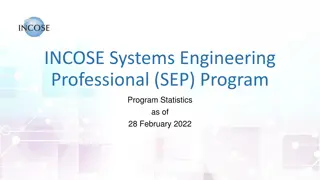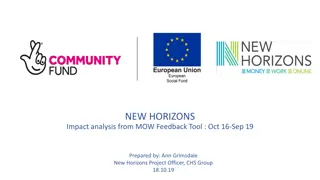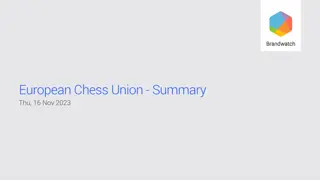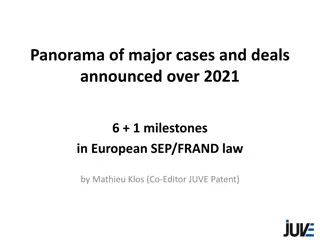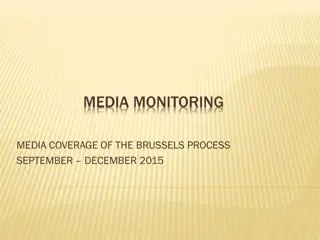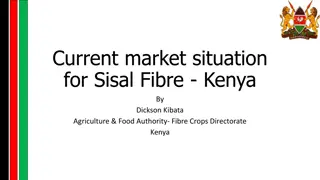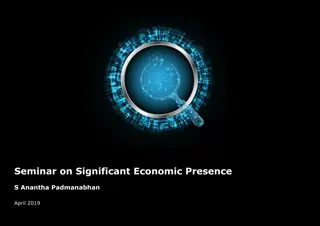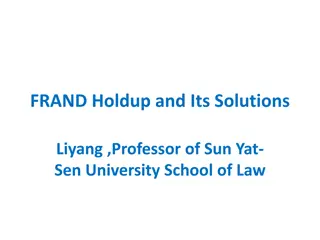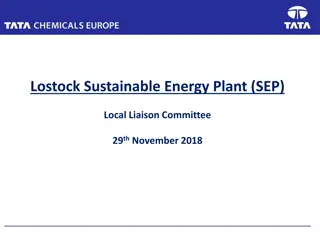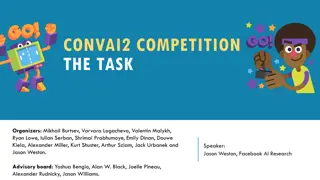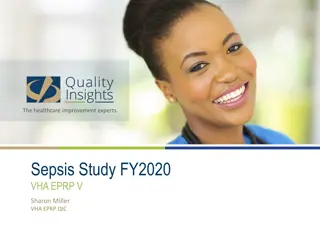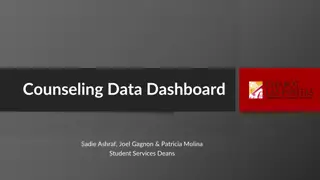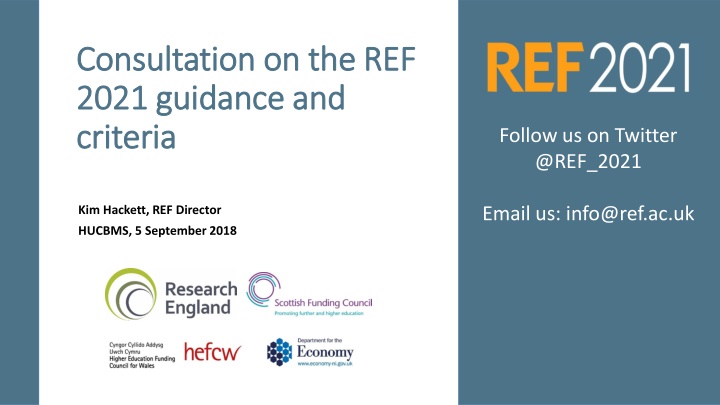
Overview of REF 2021 Guidance and Criteria Changes
Explore key changes in the REF 2021 guidance and criteria, including submissions, panel criteria, and important deadlines for consultation responses. Find out about the consultation process, impact criteria, and more.
Download Presentation

Please find below an Image/Link to download the presentation.
The content on the website is provided AS IS for your information and personal use only. It may not be sold, licensed, or shared on other websites without obtaining consent from the author. If you encounter any issues during the download, it is possible that the publisher has removed the file from their server.
You are allowed to download the files provided on this website for personal or commercial use, subject to the condition that they are used lawfully. All files are the property of their respective owners.
The content on the website is provided AS IS for your information and personal use only. It may not be sold, licensed, or shared on other websites without obtaining consent from the author.
E N D
Presentation Transcript
Consultation on the REF Consultation on the REF 2021 guidance and 2021 guidance and criteria criteria Follow us on Twitter @REF_2021 Email us: info@ref.ac.uk Kim Hackett, REF Director HUCBMS, 5 September 2018
Overview Introduction to consultation Key changes since 2014 Guidance on submissions Panel criteria Next steps and further information
Consultation Responses by noon, 15 October 2018 online form at www.ref.ac.uk
Further documentation Draft guidance on codes of practice Guidance and briefings provided to panels List of independent research fellowships Guidance on standardising quantitative indicators for impact Guidance for using quantitative indicators in the environment
2021 framework Overall quality Impact Environment Outputs FTE x 2.5 = number of outputs required Environment data and template Impact case studies 60% 15% 25%
Key changes since REF 2014 Overall framework Overall framework Submission of all staff with significant responsibility for research Transitional approach to non-portability of outputs Decoupling of staff from outputs Open access requirements Additional measures to support interdisciplinary research Broadening and deepening definitions of impact Panel criteria Panel criteria Aim for continuity with 2014 and greater consistency across main panels, where possible.
Guidance on submissions Specific consultation areas Specific consultation areas proposed approach for taking account of staff circumstances some specific points, inc around eligibility: clarity, usefulness and coverage of the list of independent research fellowships proposed eligibility arrangements for seconded staff proposed ineligibility of staff based in a discrete department or unit outside the UK proposal to make ineligible the outputs of former staff who have been made redundant (except where the staff member has taken voluntary redundancy) eligibility of co-authored outputs more than once within the same submission clarity and usefulness of the glossary of output types capturing cost activity level in UOA 4 PLUS comments on overall clarity of the guidance, including annexes
Staff submission All staff with significant responsibility for research should be returned to the REF Category A eligible Category A submitted - Teaching and Research or Research only Accurately identifies staff with significant responsibility for research 100 per cent returned - Independent researcher Staff with significant responsibility returned, following process developed, consulted on and documented - Minimum of 0.2 FTE Some T&R staff do not have significant responsibility for research - Substantive connection Approach may vary by UOA where employment practices vary at this level
More on eligibility Substantive connection Substantive connection Statement required for staff on 0.20-0.29 FTE evidence of participation in and contribution to the unit s research environment evidence of wider involvement in the institution evidence of research activity focused in the institution period of time with the institution Statement not required where particular personal and discipline-related circumstances apply Independent researcher Independent researcher An individual who undertakes self-directed research, rather than carrying out another individual s research programme Guidance includes indicators to support HEIs Research assistants / associates not normally eligible
Significant responsibility Staff for whom: Staff for whom: Explicit time and resources are made available proportion of time allocated for research, as determined in the context of the institution s practices and applied in a consistent way research allocation in a workload model or equivalent. to engage actively in independent research eligibility to apply for research funding as the lead or co-applicant access to research leave or sabbaticals membership of research centres or institutes within the HEI. and that is an expectation of their job role. current research responsibilities as indicated in, for example, career pathways or stated objectives expectations of research by role as indicated in, for example, job descriptions and appraisals.
Outputs decoupling Number of outputs per submission Output pool to include Max of 5 attributed to individuals FTE of Cat A submitted May include outputs of staff that have left Min of 1 per Cat A submitted Number of outputs Submitted outputs 2.5
Outputs non-portability Transitional approach to non-portability Outputs may be submitted by: the institution employing the eligible staff member on the census date; and the institution employing the eligible staff member when the output was demonstrably generated Demonstrably generated date when the output was first made publicly available For former staff: Includes: for staff still employed, but no longer on eligible contract, outputs produced while employed as eligible; and outputs of staff on secondment / leave of absence Excludes: any outputs produced before / after period of eligible employment; outputs of staff made redundant (subj to consultation)
Staff circumstances Consulting on measures to support equality and diversity and recognise the effect that staff circumstances may have on unit s research productivity and on individual contribution to pool. Reduction in unit s required no. of outputs Reduction in unit s required no. of outputs Removal of minimum of one output Removal of minimum of one output Exceptional circumstances where the individual has not been able to produce an output Optional reduction in output requirement where staff have not been able to research productively due to individual circumstances. Defined reductions for: Individual may be returned without min. of one output Early career researchers Unit s output requirement will be further reduced by one Secondments/career breaks Family-related leave Clinical lectureships Plus circumstances equivalent to absence that require a judgement
Codes of practice Code of practice to cover: Process(es) for identifying staff with significant responsibility for research (where not submitting 100%) Process(es) for determining who is an independent researcher Process for ensuring a fair approach to selecting outputs Draft Guidance on codes of practice, including template at www.ref.ac.uk. EDAP will examine the codes and advise the funding bodies. Deadline for submission: 7 June 2019. Publication intended by end of 2019.
Interdisciplinary research Interdisciplinary identifier For the purposes of the REF, interdisciplinary research is understood to achieve outcomes (including new approaches) that could not be achieved within the framework of a single discipline. Interdisciplinary research features significant interaction between two or more disciplines and / or moves beyond established disciplinary foundations in applying or integrating research approaches from other disciplines. No advantage or disadvantage in the assessment in identifying outputs as IDR. Specific guidance to panels on applying assessment criteria to IDR outputs
Interdisciplinary research Panel structures IDAP: oversee application of agreed principles and processes provide advice and support for cross-panel collaboration Main panel interdisciplinary leads: facilitate cross-panel liaison oversee calibration exercise for IDR outputs Sub-panel interdisciplinary advisers: offer guidance to sub-panels on assessment of IDR outputs liaise with advisers on other panels
Outputs open access Outputs deposited as soon after the point of acceptance as possible, and no later than three no later than three months months after this date from 1 April 2018. Deposit exception from 1 April 2018 outputs remain compliant if they are deposited up to three months after the date of publication. Additional flexibility 5% tolerance band per submission
Impact Consistency with REF 2014 Impact remains non-portable 2* quality threshold Timeframe: 1 January 2000 - 31 December 2020 for underpinning research 1 August 2013 - 31 July 2020 for impacts Refinements Impact template integrated into Environment statement Impact on teaching within (and beyond) own HEI is eligible Enhanced clarity on scope of underpinning research bodies of work Guidance on submitting continued impact case studies Aim for enhanced clarity in guidance on public engagement
Environment Structure: a. Unit context, research and impact strategy. b. People, including: staffing strategy and staff development research students equality and diversity. c. Income, infrastructure and facilities. d. Collaboration and contribution to the research base, economy and society. Information on impact to be included across the four sections Advice from working group of Forum for Responsible Research Metrics on use of quantitative indicators to support the narrative
Institutional level assessment of environment Institutional-level information will be appended to the UOA-level environment template and will be taken into account by the sub-panel when assessing the unit-level statement. Pilot of the standalone assessment of the discrete institutional-level environment will draw on this submitted information. Outcomes from the separate pilot exercise will not 2021 but will inform future research assessment. not be included in REF
Panel criteria Aims Aims build on REF 2014 criteria to maintain continuity achieve consistency across the main panels, where possible, while taking into account disciplinary differences Structure Structure Unit of assessment (UOA) descriptors Panel criteria (submissions, outputs, impact, environment) Panel procedures Working methods
Panel criteria One statement of combined criteria Supplementary criteria boxes relevant to individual main panels colour coded
Panel criteria - consultation We invite comments on: We invite comments on: whether the criteria are appropriate and clear where further clarification is required where refinements could be made where more consistency across panels could be achieved where differences between disciplines could justify further differentiation between main panels PLUS specific questions on: PLUS specific questions on: double-weighted outputs Main Panel D guidance on output types section weightings in the Environment statement
Outputs criteria Rigour Significance Originality the extent to which the output makes an important and innovative contribution to understanding and knowledge in the field the extent to which the work has influenced, or has the capacity to influence, knowledge and scholarly thought, or the development and understanding of policy and/or practice the extent to which the work demonstrates intellectual coherence and integrity, and adopts robust and appropriate concepts, analyses, theories and methodologies Scored one to four star (or unclassified) Scored one to four star (or unclassified) Each main panel sets out its own understanding of the starred quality levels All outputs meeting REF definition of research are eligible, with all forms of output considered equitably Panels will not use journal impact factors or hierarchies of journals in assessment
Impact criteria Reach Significance the extent and/or diversity of the beneficiaries of the impact, as relevant to the nature of the impact. (It will not be assessed in geographic terms, nor in terms of absolute numbers of beneficiaries.) the degree to which the impact has enabled, enriched, influenced, informed or changed the performance, policies, practices, products, services, understanding, awareness or well-being of the beneficiaries. Case studies describing any type(s) of impact welcomed (extensive but not exhaustive list of examples of impact and indicators at Annex A) Case studies describing impacts through public engagement welcomed Case studies must provide a clear and coherent narrative supported by verifiable evidence and indicators
Environment criteria Assessment criteria: Vitality Sustainability the extent to which a unit supports a thriving and inclusive research culture for all staff and research students, that is based on a clearly articulated strategy for research and enabling its impact, is engaged with the national and international research and user communities and is able to attract excellent postgraduate and postdoctoral researchers. the extent to which the research environment ensures the future health, diversity, well-being and wider contribution of the unit and the discipline(s), including investment in people and in infrastructure.
Timetable Spring 2018 Panels met to develop criteria Consultation on draft guidance and criteria Draft guidance on codes of practice Consultation deadline: noon, 15 October 2018 Consultation deadline: noon, 15 October 2018 Summer to Autumn 2018 Early 2019 Publish final guidance and criteria Complete preparation of submission systems Submission Submission deadline for codes of practice: noon, 7 June 2019 deadline for codes of practice: noon, 7 June 2019 2019 Submission phase Submission deadline: noon, 27 November 2020 Submission deadline: noon, 27 November 2020 2020 Assessment phase Publication Publication of results: December 2021 of results: December 2021 2021
Further information Webinars and HEI briefing events www.ref.ac.uk/events Enquiries from staff at HEIs should be directed to their nominated institutional contact (available at www.ref.ac.uk/contact) Other enquiries to info@ref.ac.uk


